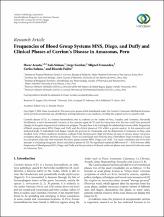| dc.contributor.author | Acosta, Óscar | |
| dc.contributor.author | Solano, Luis | |
| dc.contributor.author | Escobar, Jorge | |
| dc.contributor.author | Fernandez, Miguel | |
| dc.contributor.author | Solano, Carlos | |
| dc.contributor.author | Fujita, Ricardo | |
| dc.creator | Acosta, Óscar | |
| dc.date.accessioned | 2016-03-11T11:39:50Z | |
| dc.date.available | 2016-03-11T11:39:50Z | |
| dc.date.issued | 2014 | |
| dc.identifier.citation | Oscar Acosta, Luis Solano, Jorge Escobar, Miguel Fernandez, Carlos Solano, and Ricardo Fujita, “Frequencies of Blood Group Systems MNS, Diego, and Duffy and Clinical Phases of Carrion’s Disease in Amazonas, Peru,” Interdisciplinary Perspectives on Infectious Diseases, vol. 2014, Article ID 576107, 8 pages, 2014. doi:10.1155/2014/576107 | es_PE |
| dc.identifier.uri | https://hdl.handle.net/20.500.12727/1533 | |
| dc.description.abstract | Carrion’s disease (CD), is a human bartonellosis, that is, endemic in the Andes of Peru, Ecuador, and Colombia. Bartonella
bacilliformis, a native hemotrophic bacteria, is the causative agent of CD, and the interaction with the host could have produced
changes in the gene frequencies of erythrocyte antigens.The goal here is to investigate the relationship between allele frequencies
of blood group systems MNS, Diego, and Duffy and the clinical phases of CD, within a genetic context. In this associative and
analytical study, 76 individuals from Bagua Grande, the province of Utcubamba, and the department of Amazonas in Peru, were
enrolled. Forty of them resided in Tomocho-Collicate-Vista Hermosa area (high prevalence of cases in chronic phase, verrucous,
or eruptive phase, without previous acute phase). Thirty-six individuals were from the area of Miraflores (high prevalence of cases
in acute phase only) and were evaluated for blood group systems MNS, Diego, and Duffy. This study constitutes one of the first
attempts at evaluating the genetic factors and clinical phases of CD. No significant statistical differences (𝑃 > 0.05) between allele
frequencies of blood groups MNS, Diego, and Duffy and the prevalence of chronic and acute phases were detected in the two areas
of Amazonas, Peru. | es_PE |
| dc.description.sponsorship | Universidad de San Martín de Porres, Facultad de Medicina Humana. Universidad Nacional Mayor de San Marcos, Facultad de Medicina Humana | es_PE |
| dc.format.extent | 8 p. | es_PE |
| dc.language.iso | eng | es_PE |
| dc.publisher | Interdisciplinary Perspectives on Infectious Diseases | es_PE |
| dc.relation.ispartof | urn:issn:1687-7098 | |
| dc.relation.ispartofseries | Interdisciplinary Perspectives on Infectious Diseases;vol 2014, Article ID 576107 | |
| dc.relation.uri | http://www.hindawi.com/journals/ipid/2014/576107/ | en_US |
| dc.rights | info:eu-repo/semantics/openAccess | es_PE |
| dc.rights.uri | https://creativecommons.org/licenses/by/4.0/ | es_PE |
| dc.source | REPOSITORIO ACADÉMICO USMP | es_PE |
| dc.source | Universidad de San Martín de Porres – USMP | es_PE |
| dc.subject | Infecciones por Bartonella | es_PE |
| dc.subject | Enfermedades endémicas | es_PE |
| dc.subject | Ecosistema andino | es_PE |
| dc.subject.ddc | 616 - Enfermedades | es_PE |
| dc.title | Frequencies of Blood Group Systems MNS, Diego, and Duffy and Clinical Phases of Carrion’s Disease in Amazonas, Peru | |
| dc.type | info:eu-repo/semantics/article | es_PE |
| thesis.degree.name | Medicina Humana | es_PE |
| thesis.degree.grantor | Universidad de San Martín de Porres. Facultad de Medicina Humana | es_PE |
| thesis.degree.discipline | Medicina | es_PE |
| dc.identifier.doi | http://dx.doi.org/10.1155/2014/576107 | |
| dc.subject.ocde | https://purl.org/pe-repo/ocde/ford#3.02.00 | es_PE |








